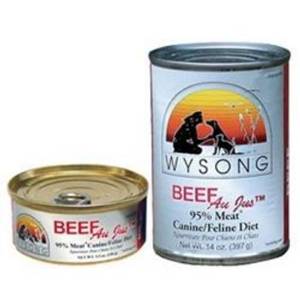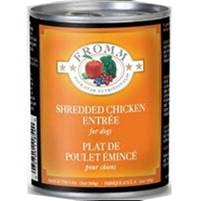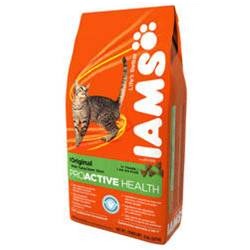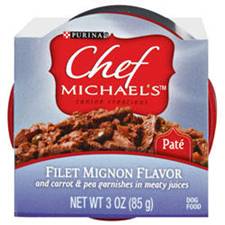What is in a Name?Brand Names: Dogs and cats are special members of your family and you want to provide them with the best nutrition possible. “Canine Caviar”, “Friskies”, “Halo”, “Beneful”, “Wellness”, “Pedigree”, “Solid Gold” all seem to say, “Our food is good for your pet”. These are all Brand Names and their intent is to influence which products you purchase. Many consumers put their trust in brand names. That is exactly what companies hope for... loyal customers. While this may be acceptable when buying blue jeans or appliances, blind trust in a pet food brand name can and has killed pets. Smart shoppers make educated decisions. They look past branding and read the ingredients label.
The "95%" rule applies to meat, poultry or fish canned products. They usually have simple names with the type of meat boldly listed first, such as this example by Wysong. This means that at least 95% of the product is comprised of the named ingredient. The actual ingredients listed for this food are “Beef and Water Sufficient for Processing, Beef Liver, Animal Plazma and Guar Gum.” The "25%" or "Dinner" rule applies to many canned and dry products. The named ingredients must comprise at least 25% of the product - not counting the water for processing - but less than 95%. The ingredient name must include a qualifying descriptive term, such as “Dinner”, "Platter," "Entree," "Nuggets," "Formula” or the like. Our example is "Fromm Shredded Chicken Entrée for dogs". Notice the first few ingredients of this product. The "3%" or "With" rule was intended to point out notable ingredients not in sufficient quantity to merit a "dinner" claim. The AAFCO allows use of the term "with" as part of the product name, such as the example here, Reading the ingredients label of this product shows how very little tuna is actually present. “Chicken By-Product Meal, Corn Meal, Corn Grits, Animal Fat (preserved with mixed Tocopherols, a source of Vitamin E), Tuna, Dried Beet Pulp, Dried Egg Product, Natural Flavor, Sodium Bisulfate, Potassium Chloride…” The "Flavor" rule does not require any specific percentage, only a detectible amount. The specific test method uses animals trained to prefer specific flavors. In the example of "Chef Michael’s Filet Mignon Flavor Pate Canned Dog Food," Against The Grain’s advice: Forget the tempting pictures and wording on the front of the packaging. Learn to read the ingredient label. It is really, very easy and your healthy pet will thank you. Against The Grain Pet Nutrition is a company that does things differently. We are a small business that is excited about offering pet owners better choices in pet nutrition. We believe that choosing appropriate pet food (be it commercial, raw or home prepared) is the most important factor in any pet's preventative health, convalescence and longevity. Our name - Against The Grain - reflects our strong passion to provide pet owners with the knowledge to make healthy decisions about pet care even if we go ‘against the grain' of popular thinking. 
 To contact us:
To contact us:www.ATGPetNutrition.com 1024 County Road 109 Montevallo, AL 35115 Phone: 205-665-9026 Fax: 205-665-5683 [email protected] Copyright © 2024 Against The Grain Pet Nutrition, LLC.
|




 95% Rule
95% Rule “Chicken, Chicken Broth, Carrots, Potatoes, Peas, Potato Starch, Tomato Paste, Calcium Sulfate, Choline Chloride, Salt…” Considering the water content in chicken, the vegetables probably make up a considerable percentage of this food.
“Chicken, Chicken Broth, Carrots, Potatoes, Peas, Potato Starch, Tomato Paste, Calcium Sulfate, Choline Chloride, Salt…” Considering the water content in chicken, the vegetables probably make up a considerable percentage of this food.  “Iams Original with Tuna Proactive Health Cat Food”. The 3% rule is tricky because now even a minor change in wording can reflect huge differences. For example, Cat Food with Tuna is only required to have 3% tuna. Tuna Cat Food is 95% tuna.
“Iams Original with Tuna Proactive Health Cat Food”. The 3% rule is tricky because now even a minor change in wording can reflect huge differences. For example, Cat Food with Tuna is only required to have 3% tuna. Tuna Cat Food is 95% tuna. the word "flavor" must appear on the label in the same size, style and color as the word "filet mignon." Actual ingredients are “Water sufficient for processing, beef, chicken, liver, meat by-products, wheat gluten, carrots, peas, added color, artificial and natural flavors, natural filet mignon flavor, salt…”
the word "flavor" must appear on the label in the same size, style and color as the word "filet mignon." Actual ingredients are “Water sufficient for processing, beef, chicken, liver, meat by-products, wheat gluten, carrots, peas, added color, artificial and natural flavors, natural filet mignon flavor, salt…”